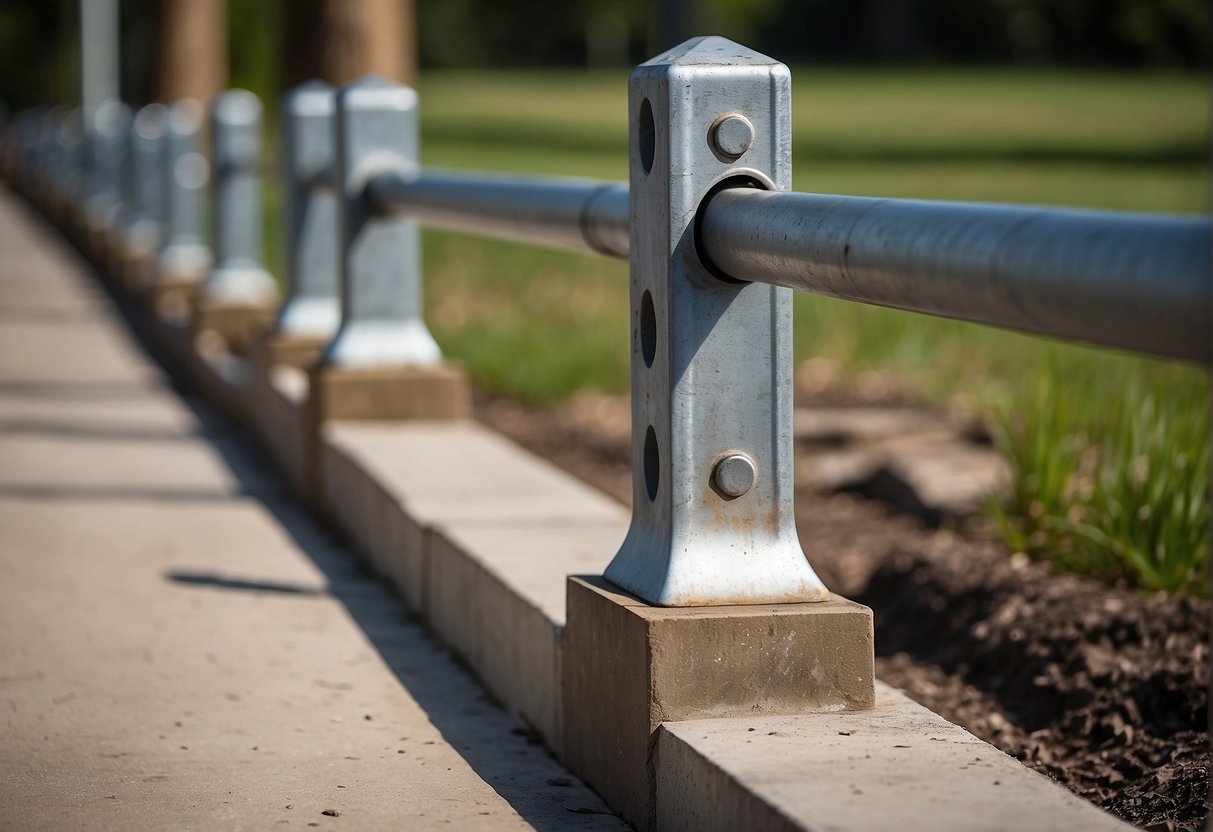When it comes to installing a fence, one of the most important decisions you’ll need to make is how to secure the fence posts. Two popular options are fence post anchors and concrete. Each option has its own set of pros and cons, making it important to understand the differences between them before making a decision.
Fence post anchors are metal or plastic brackets that attach to the bottom of the fence post and then anchor into the ground. They are quick and easy to install, making them a popular choice for DIY projects. On the other hand, concrete is a traditional and reliable option that involves digging a hole, placing the post in it, and then pouring concrete around it to hold it in place. While concrete takes longer to install, it is generally considered to be more durable and long-lasting than fence post anchors.
Key Takeaways
- Fence post anchors and concrete are two popular options for securing fence posts.
- Fence post anchors are quick and easy to install, while concrete is more durable and long-lasting.
- The decision between fence post anchors and concrete depends on various factors such as the installation process, tools required, and personal preferences.
Understanding Fence Post Anchors and Concrete
As a homeowner, choosing the right foundation for your fence post is essential. Two common options are fence post anchors and concrete. In this section, I will discuss the types of fence post anchors and concrete as a fence post foundation.
Types of Fence Post Anchors
Fence post anchors come in different types and materials, such as wood and metal. One popular type of fence post anchor is the anchor spike, which is made of galvanized steel and has a pointed end for easy installation. Anchor spikes offer a simpler and quicker installation process compared to concrete. They eliminate the need for digging holes and pouring concrete, making the overall process faster and more convenient. Additionally, fence post anchor spikes provide a sturdy foundation for fences and help prevent post rot by keeping the wooden posts off the ground and away from moisture.
Another type of fence post anchor is the drive-in post spike, which is made of metal and has a V-shaped design that allows it to be driven into the ground using a hammer or mallet. Drive-in post spikes are ideal for soft soil types and offer a secure and stable foundation for fences.
Concrete as a Fence Post Foundation
Concrete is a popular option for fence post foundations due to its durability and strength. It provides a solid and long-lasting foundation for fences, making it a suitable option for areas with harsh weather conditions and high winds.
When using concrete as a fence post foundation, it’s important to note that small gaps may develop near the base of the fence due to wood contraction and expansion throughout the year. To prevent this, it’s recommended to use a concrete mix with a flexible additive or to install a gravel base around the fence post before pouring the concrete.
In conclusion, both fence post anchors and concrete have their advantages and disadvantages. Fence post anchors are faster and easier to install, while concrete provides a more durable and long-lasting foundation. The choice ultimately depends on your specific needs and preferences.
Pros and Cons of Fence Post Anchors
Advantages of Using Anchors
As a fencing contractor, I have found that fence post anchors offer several advantages over traditional concrete posts. Firstly, they are much easier to install. Unlike concrete posts, which require digging holes and pouring concrete, fence post anchors can be easily driven into the ground using a sledgehammer or post driver. This makes them a great option for DIY enthusiasts who want to install their own fence.
Another advantage of fence post anchors is that they are flexible. Once installed, they allow for some movement in the fence, which can be helpful in areas with high winds or other environmental factors. Additionally, fence post anchors are easy to remove if you need to make changes or repairs to your fence. Simply remove the anchor and replace it with a new one.
Limitations of Post Anchors
Despite their advantages, fence post anchors also have some limitations. One of the main limitations is that they are not as secure as concrete posts. While they are great for most residential fencing applications, they may not be suitable for high-security applications or areas with extreme weather conditions.
Another limitation of fence post anchors is that they may not be as resistant to rot and moisture as concrete posts. This is because they are typically made from metal or plastic, which can be susceptible to rust or degradation over time. Therefore, it is important to regularly inspect your fence post anchors and replace them if necessary to ensure that your fence remains secure and stable.
In conclusion, fence post anchors offer several advantages over traditional concrete posts, including ease of installation and flexibility. However, they may not be as secure or resistant to rot and moisture as concrete posts. As a fencing contractor, I always recommend considering the specific needs of your fencing application before deciding on which type of post to use.
Pros and Cons of Using Concrete
Benefits of Concrete Foundations
When it comes to fence post foundations, concrete is one of the most popular options. One of the main benefits of using concrete is that it provides a permanent and sturdy foundation for your fence. Concrete is a strong and durable material that can withstand harsh weather conditions and heavy winds, making it an ideal choice for areas with extreme weather patterns.
Another advantage of using concrete is that it is a long-lasting solution. Once you pour the concrete and let it cure, you can expect it to last for many years without requiring any significant maintenance. This means that you won’t have to worry about replacing your fence posts or repairing any damage caused by weather or other factors.
Drawbacks of Concrete for Fence Posts
While concrete is a popular choice for fence post foundations, it does have some drawbacks that you should consider before making a decision. One of the main drawbacks of using concrete is that it can be expensive to pour and install. You will need to purchase the concrete mix, as well as any tools or equipment required for the job.
Another drawback of using concrete is that it is not very flexible. Once you pour the concrete, it is difficult to make any changes or adjustments to the foundation. This means that if you need to move your fence or make any modifications to it, you may need to remove the entire foundation and start from scratch.
Finally, while concrete is a sturdy and long-lasting material, it does require some maintenance over time. You may need to patch any cracks or holes that develop in the foundation, or apply a sealant to prevent water damage. This can add to the overall cost of using concrete for your fence post foundations.
Overall, while concrete is a popular and reliable choice for fence post foundations, it does have some drawbacks that you should consider. If you’re looking for a long-lasting and sturdy solution that requires minimal maintenance, concrete may be the right choice for you. However, if you’re on a tight budget or need a more flexible foundation, you may want to consider other options such as fence post anchors.
Installation Process and Tools Required
When it comes to installing fence posts, you have two main options: using fence post anchors or setting fence posts in concrete. Both methods have their pros and cons, but the installation process and tools required can vary significantly.
Installing Fence Post Anchors
Installing fence post anchors is generally a quicker and easier process than setting fence posts in concrete. First, you’ll need to measure and mark the location of each post. Then, using a sledgehammer or mallet, you can pound the fence post anchor into the ground until it is flush with the surface.
Next, insert the post into the anchor and secure it with screws or spikes. Make sure to use a level to ensure that the post is straight and stable. Finally, fill the anchor with gravel to provide additional stability.
One of the main advantages of using fence post anchors is that they require minimal digging and no mixing of concrete. This can save a significant amount of time and effort, especially if you are installing a large fence.
Setting Fence Posts in Concrete
Setting fence posts in concrete is a more traditional method that provides excellent stability and durability. However, it is also a more time-consuming and labor-intensive process.
To set a fence post in concrete, you’ll need to dig a hole that is approximately one-third the length of the post. Then, place the post in the hole and use a level to ensure that it is straight and level.
Next, mix the concrete according to the manufacturer’s instructions and pour it into the hole around the post. Make sure to pack the concrete tightly around the post to ensure maximum stability.
After the concrete has set, you can attach the fence to the post using screws or spikes. One advantage of using concrete is that it provides a solid and stable base for your fence, which can help to prevent it from leaning or shifting over time.
In terms of tools, both methods require a few basic tools such as a level, measuring tape, and a sledgehammer or mallet. However, if you are setting fence posts in concrete, you will also need a post hole digger and a mixing tool such as a shovel or hoe.
Overall, the choice between fence post anchors and concrete will depend on your specific needs and preferences. Fence post anchors are faster and easier to install, but may not provide the same level of stability as concrete. Setting fence posts in concrete is a more traditional method that provides excellent stability, but requires more time and effort.
Factors Influencing Choice Between Anchors and Concrete
When deciding between fence post anchors and concrete, there are several factors to consider. I will discuss two main factors that can influence the decision: soil conditions and fence stability, and cost considerations and longevity.
Soil Conditions and Fence Stability
One of the most important factors to consider is the soil conditions where the fence will be installed. If the soil is rocky or hard, it can be difficult to dig deep enough holes for fence posts. Fence post anchors, also known as fence post spikes, can be a good option in this case. They eliminate the need for digging large holes or using concrete, saving time and effort. Fence post anchors are made of galvanized or powder-coated steel and come with boxes at the top to place the fence posts.
However, if the soil is soft or loose, fence post anchors may not provide enough stability for the fence. In this case, concrete footings may be a better option. Concrete footings provide a strong and stable base for the fence posts, ensuring that the fence will not shift or lean over time.
Cost Considerations and Longevity
Another important factor to consider is the cost of the initial installation and the long-term maintenance of the fence. Fence post anchors can be a more cost-effective option initially, as they require less labor and materials than concrete footings. However, they may not be as durable as concrete footings in the long run. Fence post anchors may not provide enough support for heavier or taller fences, and they may not hold up as well over time. Treated wood fence posts can also rot over time, which can further reduce the stability of the fence.
Concrete footings, on the other hand, can be a more durable option in the long run. They provide a strong and stable base for the fence posts, ensuring that the fence will remain upright and stable for many years. While concrete footings may require more initial investment, they may save you money in the long run by reducing the need for maintenance or repairs.
In conclusion, both fence post anchors and concrete footings have their advantages and disadvantages. The decision ultimately depends on the specific soil conditions, the type of fence being installed, and the budget and long-term goals of the project.
Frequently Asked Questions
What are the advantages and disadvantages of using steel fence post anchors compared to setting posts in concrete?
Steel fence post anchors have the advantage of being quicker and easier to install than concrete. They also allow for easier removal and replacement of fence posts. However, they may not be as stable as concrete, especially in areas with high winds or heavy soil. Additionally, steel fence post anchors may corrode over time, which can compromise their strength and longevity.
How do deck post bases compare to direct concrete installation for longevity and stability?
Deck post bases, also known as post brackets or post anchors, are a popular alternative to direct concrete installation for deck posts. They provide a stable and secure connection between the post and the footing, which can help prevent rot and decay. While deck post bases may be more expensive than direct concrete installation, they can be easier to install and may last longer.
Can post anchors be reliably used for fence posts, or is concrete a better option?
Post anchors can be reliably used for fence posts, but their effectiveness depends on the specific application. In areas with high winds or heavy soil, concrete may be a better option for added stability. However, post anchors can be a good choice for temporary or removable fence posts, as they allow for easier removal and replacement.
Should deck posts be set directly in concrete or mounted on footings for optimal support?
Deck posts can be set directly in concrete or mounted on footings for optimal support. Direct concrete installation provides a solid foundation for the post, while footings can help distribute the weight of the deck more evenly. The choice between the two options depends on the specific application, including the size and weight of the deck, the soil conditions, and the local building codes.
Are fence post spikes a viable alternative to concrete for securing posts?
Fence post spikes, also known as post anchors or post supports, are a popular alternative to concrete for securing fence posts. They are quick and easy to install, and can provide a stable and secure connection between the post and the ground. However, fence post spikes may not be as stable as concrete, especially in areas with high winds or heavy soil. Additionally, they may not be suitable for larger or heavier fence posts.
Is setting pole barn posts in the ground preferred or should they be mounted on concrete?
Setting pole barn posts in the ground is a common practice, but mounting them on concrete can provide added stability and longevity. Concrete can help prevent rot and decay, and can provide a solid foundation for the post. The choice between the two options depends on the specific application, including the size and weight of the pole barn, the soil conditions, and the local building codes.

Hi, I’m Sal Muller of Tooltrip.com. My DIY experience led me to understand essential power tools for home projects. Tooltrip.com guides enthusiasts and professionals in choosing right tools for any job. I provide concise top tool reviews for easier, efficient DIY.




